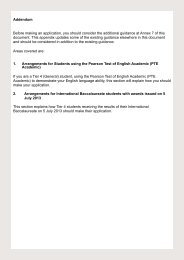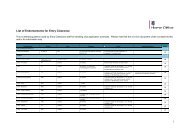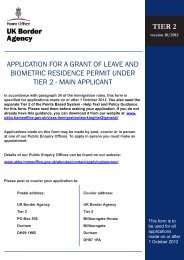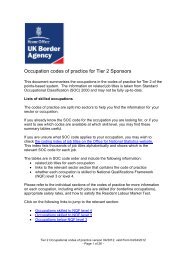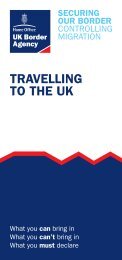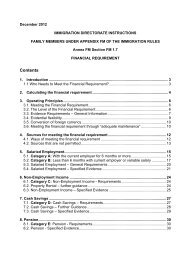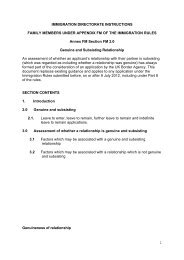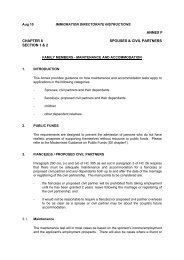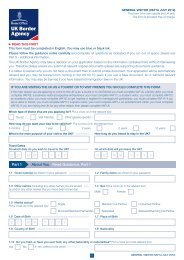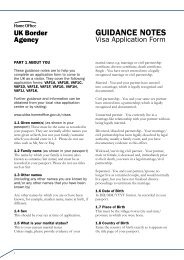COI Report March 2012 - UK Border Agency - Home Office
COI Report March 2012 - UK Border Agency - Home Office
COI Report March 2012 - UK Border Agency - Home Office
You also want an ePaper? Increase the reach of your titles
YUMPU automatically turns print PDFs into web optimized ePapers that Google loves.
SRI LANKA 7 MARCH <strong>2012</strong><br />
to the terminal buildings. Lanes are divided between Staff / Cars & Vans / Vans & Buses<br />
/ Tourist buses / Taxis. Air Force personnel manning the checkpoint approach each<br />
vehicle and ascertain if the occupants are passengers, staff or visitors. Pedestrians are<br />
also checked. Departing passengers often have to produce confirmation of ticketing<br />
and/or a passport. Staff must produce their airport ID card. Sri Lankan visitors to the<br />
airport, including drivers, often have to produce their national ID card. The registration<br />
numbers of all vehicles are written manually into a register. During heightened security<br />
situations e.g. conferences, state visits etc., the number of checkpoints may increase<br />
along roads leading to the airport, especially along the main A3 from Colombo. The<br />
police or the military can man these.‖<br />
25.19 The same BHC letter 509 continued:<br />
―The airport is split into two main terminal buildings; departure and arrivals. The<br />
departure area is restricted to departing passengers, staff, and visitors holding a ‗day<br />
pass‘ issued from an adjacent ticket booth. Persons obtaining a ‗day pass‘ have to<br />
produce a copy of their ID card or passport or driving licence, plus present the original<br />
document. Their details are recorded manually in a register. Before entering the<br />
departure terminal a security guard requires evidence of airline ticketing (and<br />
sometimes passports), staff ID cards or a day pass. Persons not holding these<br />
documents are not allowed into to the departure terminal. Immediately behind the<br />
security guard there are security checks where all bags and belongings are passed<br />
through scanners. All persons then pass through a scanner. Regardless of whether or<br />
not the detector alarm is activated, persons are then frisked by a security guard. Both<br />
male and female security staff are stationed at each checkpoint. Having passed through<br />
these security checks, persons walk through a long corridor and into the main departure<br />
area.<br />
―From the departure area there are three security entrances to the check-in area. The<br />
gate to the right caters for passengers departing on Sri Lankan Airlines; the gate to the<br />
left is for passengers on all other airlines and the gate in between is for staff only. The<br />
security guards ask passengers for evidence of ticketing and will only allow persons to<br />
pass who have produced this. Persons holding a ‗day pass‘ are not allowed into the<br />
check-in area. Immediately behind these security checks, a sign indicates ‗Customs‘. A<br />
customs officer is often seen in the vicinity, but it is not a permanent presence.<br />
Likewise, there are scanners for baggage but these are rarely seen in operation.‖<br />
25.20 The same source 510 added:<br />
―At the check-in desks, passengers have to produce their passports to airline staff and<br />
go through check-in procedures. Airline check-in staff routinely check the identity of the<br />
person against the passport details, the validity of the passport, and if the passenger<br />
has the appropriate visa for their country of destination or transit. Having checked-in,<br />
passengers then proceed to a security gate, where they produce their passport and<br />
boarding card in order to enter the Department of Immigration & Emigration (DIE) area.<br />
All passengers must complete a departure card and then queue at an immigration<br />
officer‘s desk. Passengers must present their passport, departure card and boarding<br />
pass to the immigration officer. The immigration officer scans the details page of the<br />
passport on the DIE <strong>Border</strong> Control System database. Three scanned images of the<br />
509 British High Commission Colombo, letter dated 5 January <strong>2012</strong><br />
510 British High Commission Colombo, letter dated 5 January <strong>2012</strong><br />
196 The main text of this <strong>COI</strong> <strong>Report</strong> contains the most up to date publicly available information as at 3 February <strong>2012</strong>.<br />
Further brief information on recent events and reports has been provided in the Latest News section<br />
to 2 <strong>March</strong> <strong>2012</strong>.



